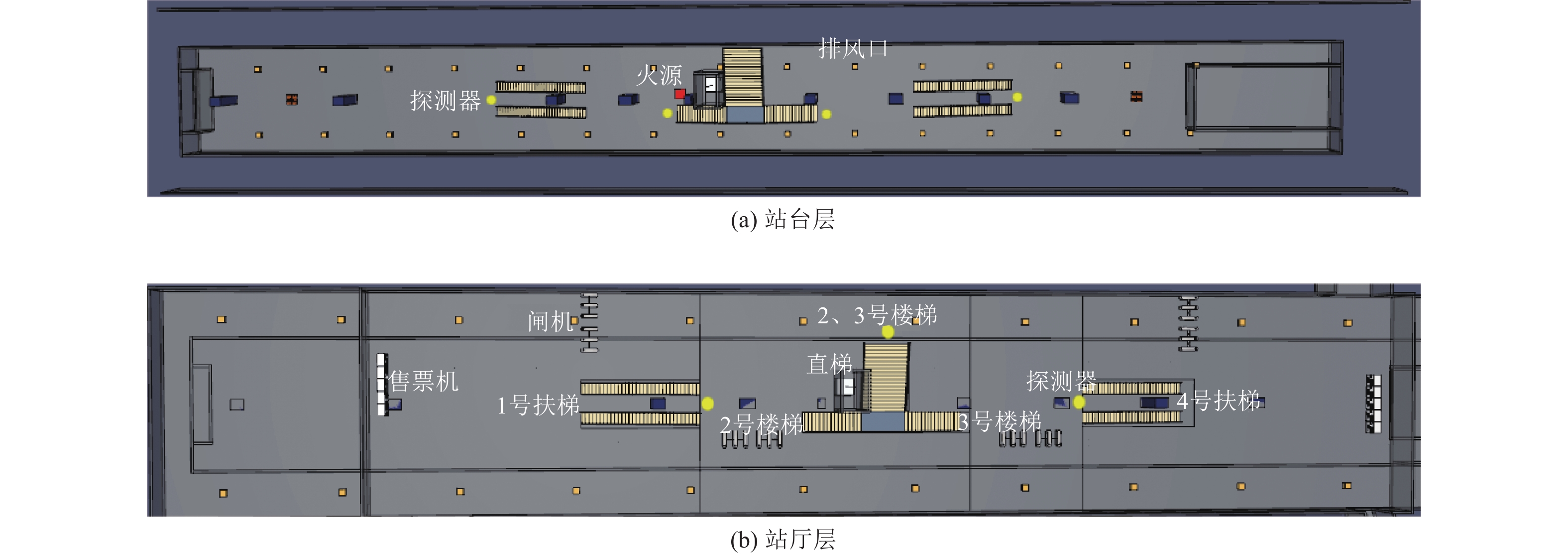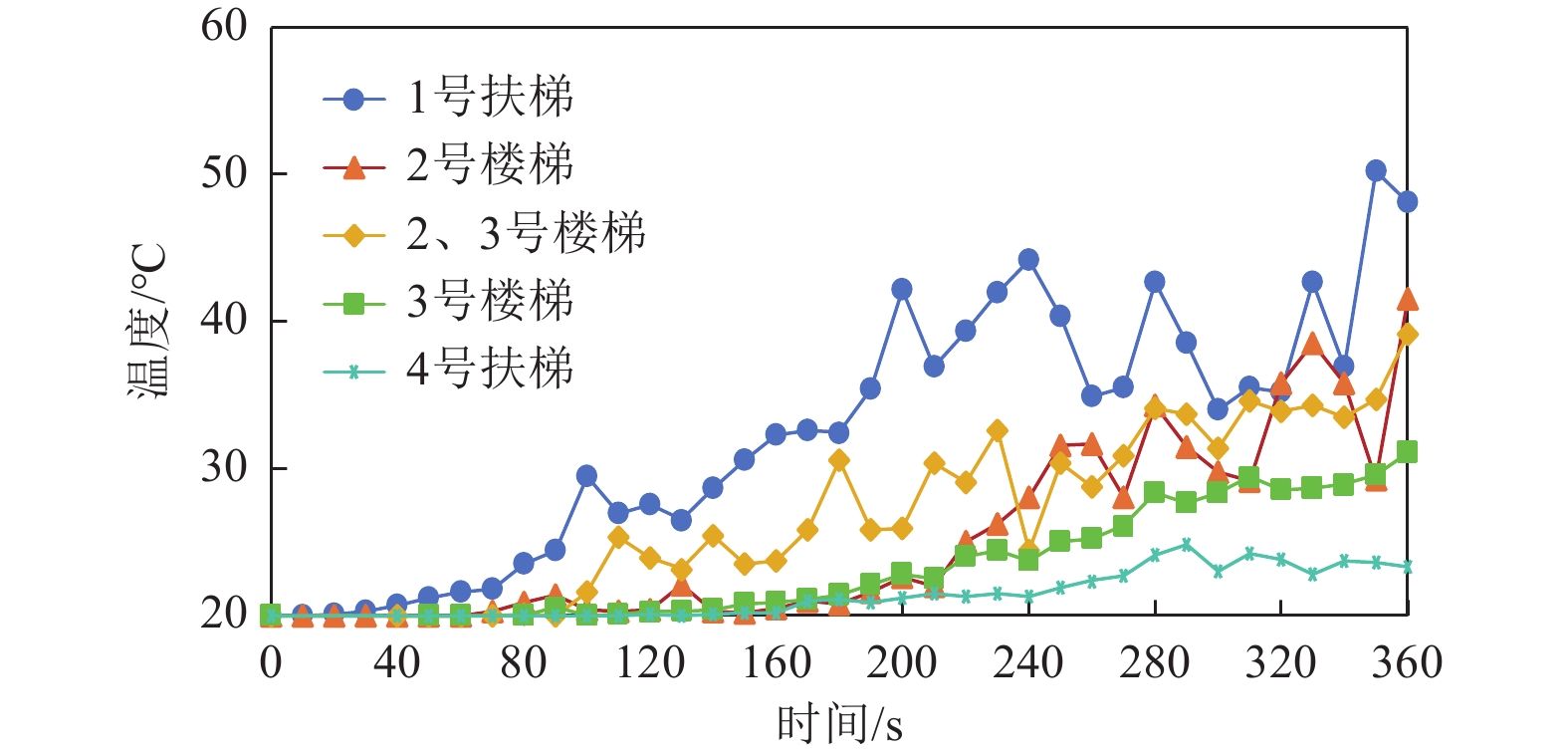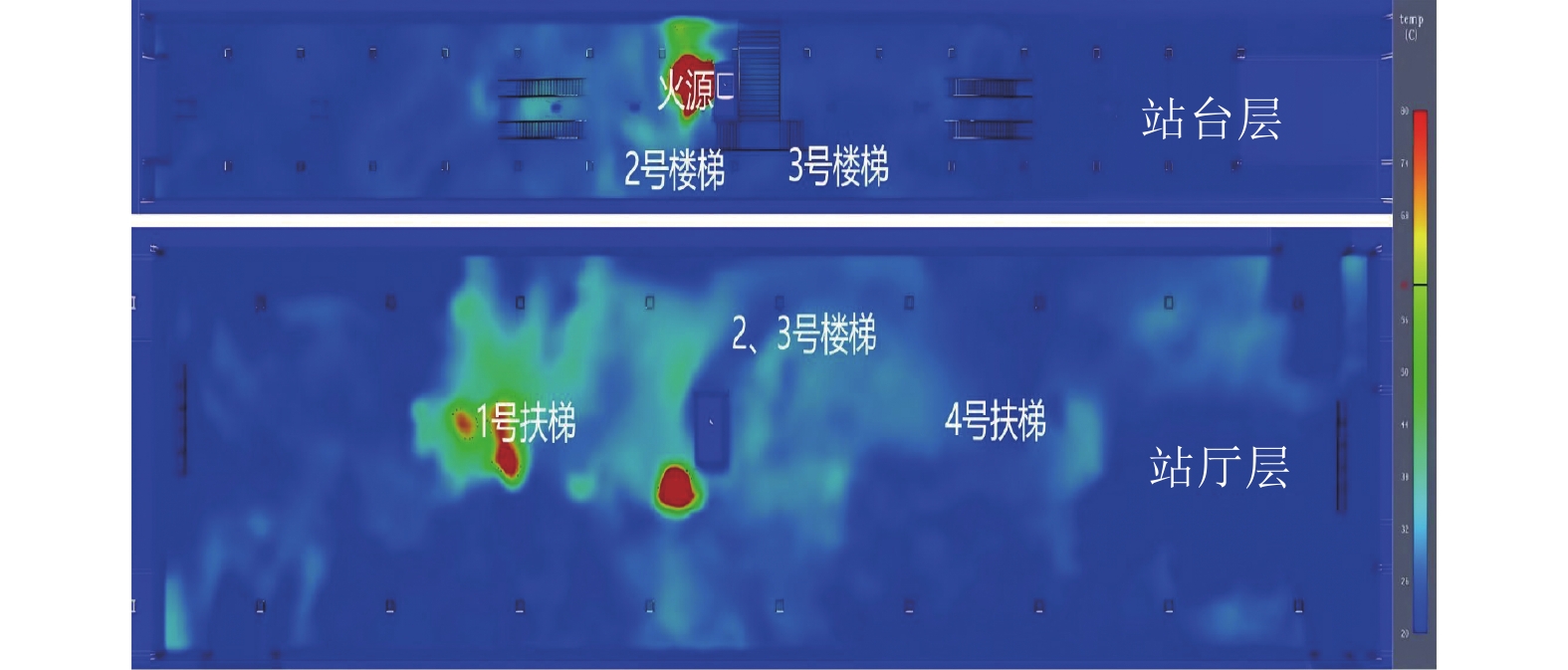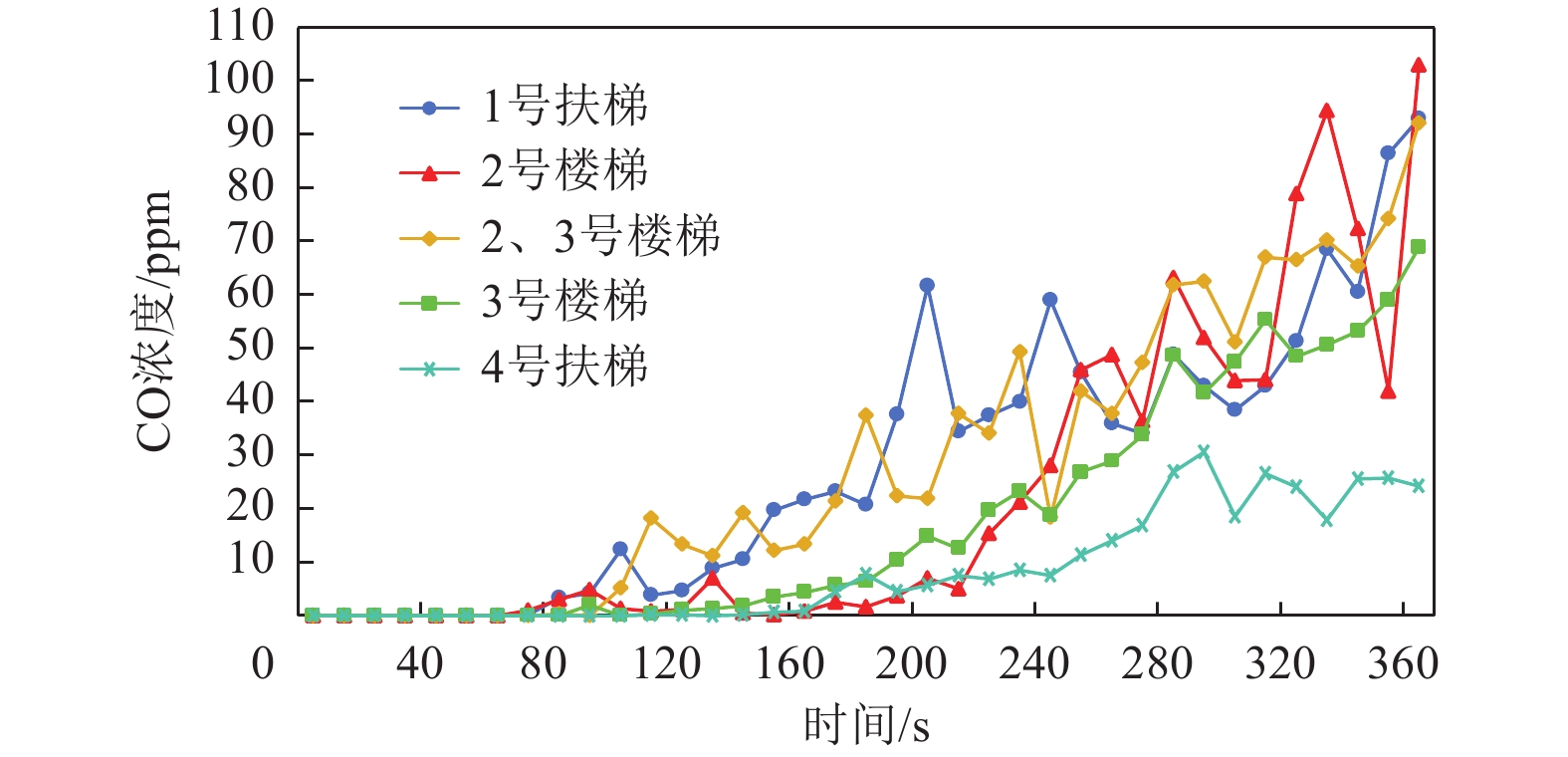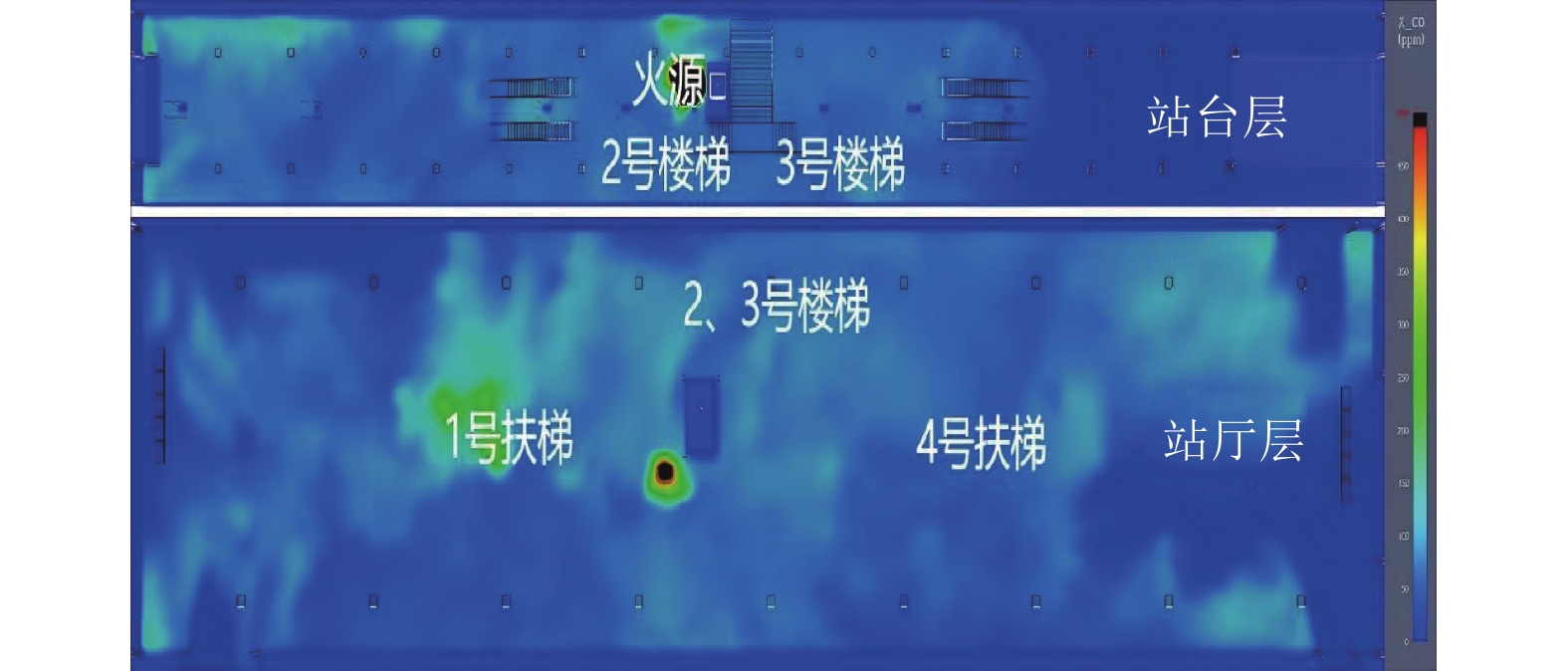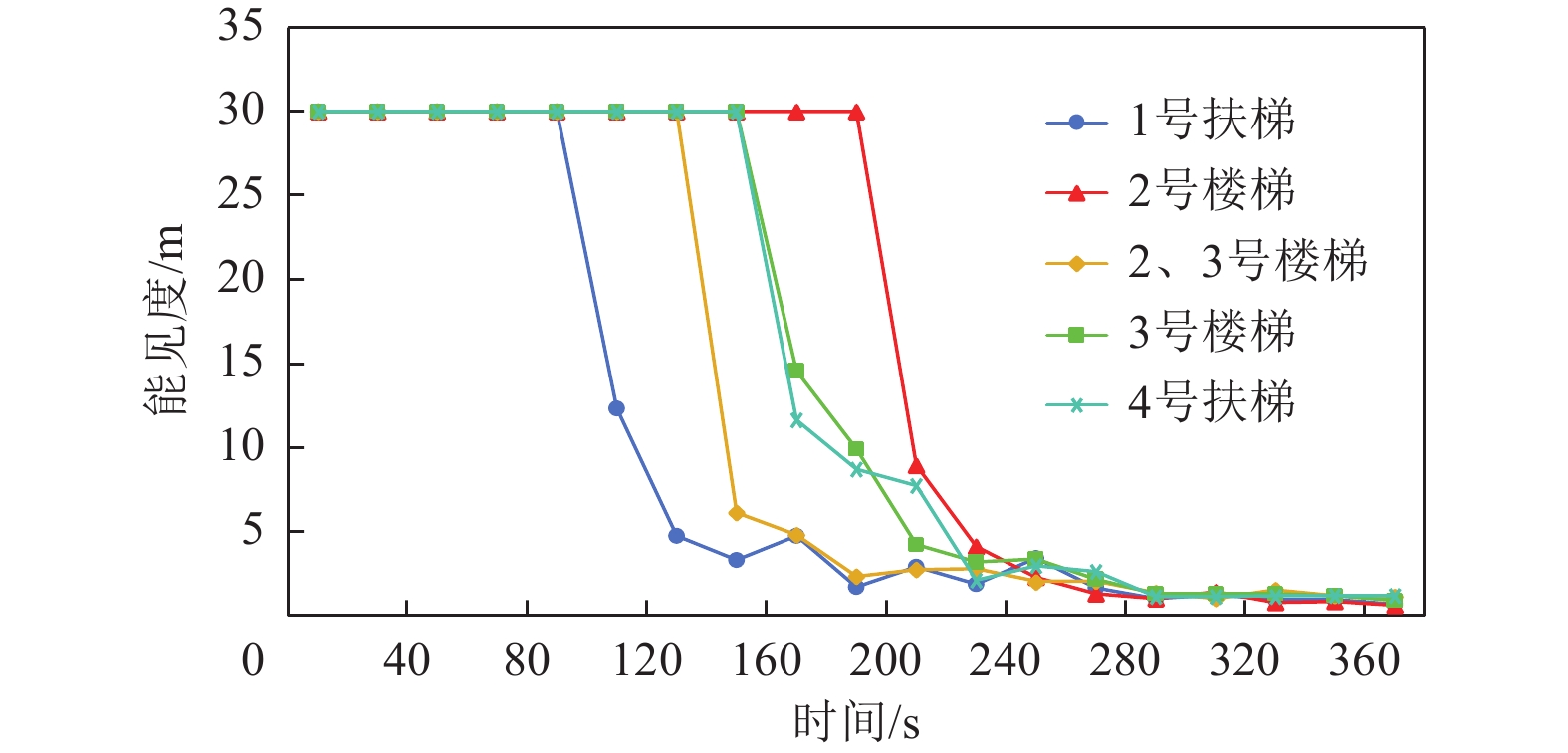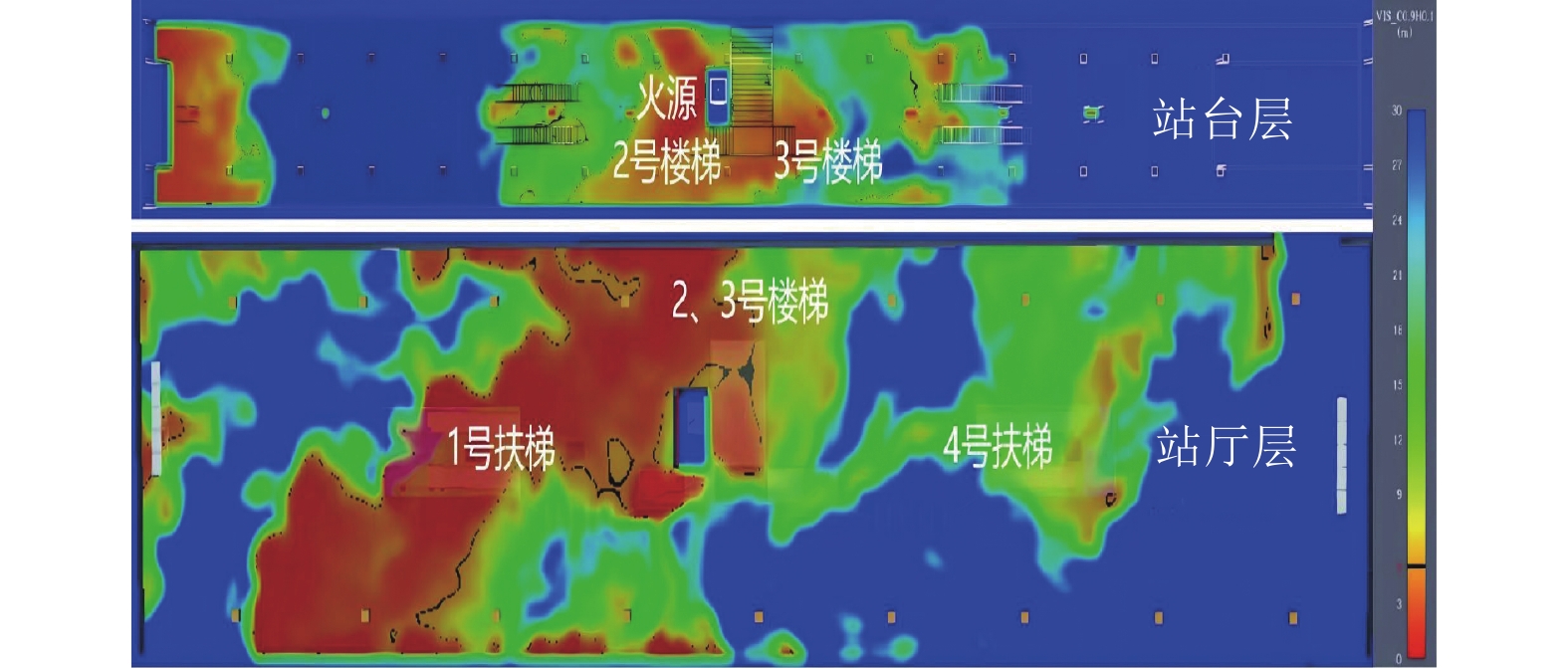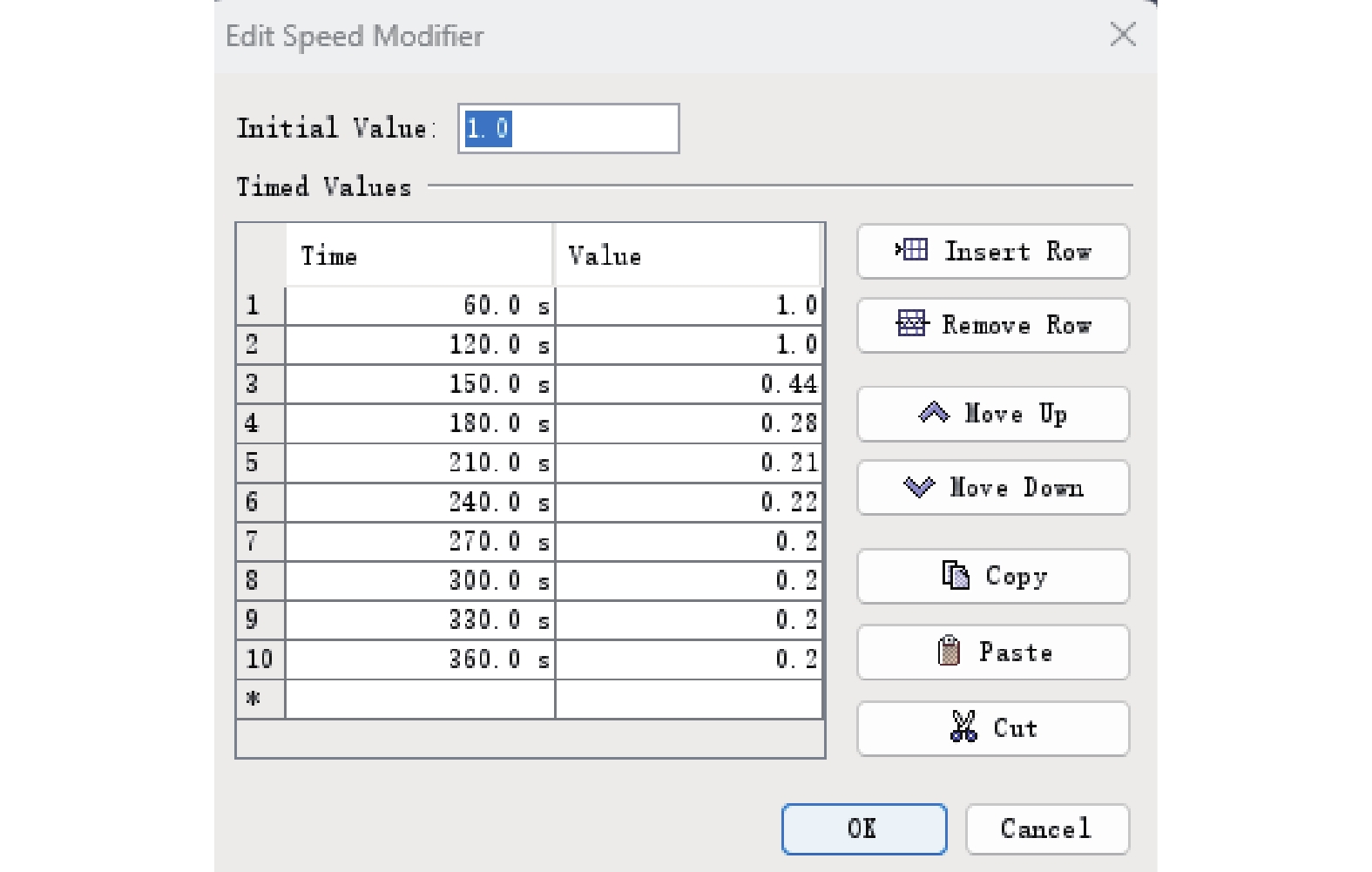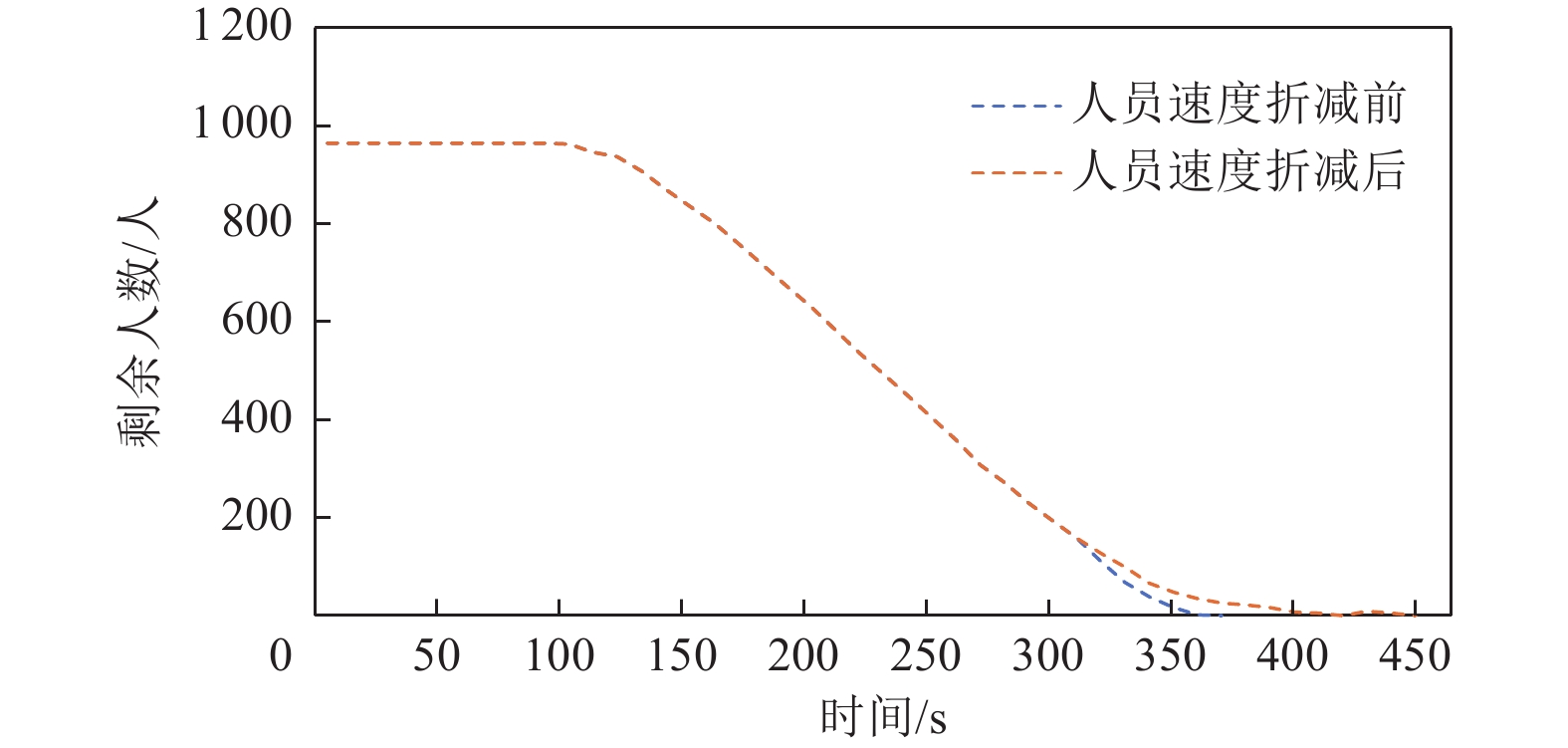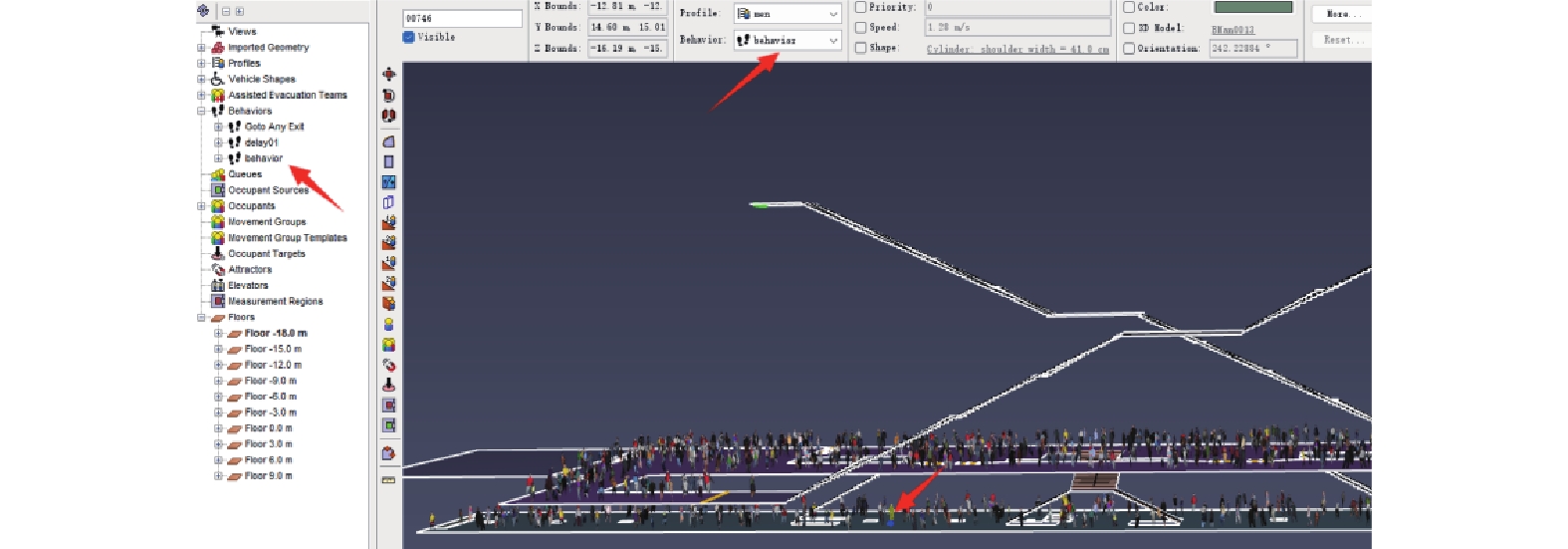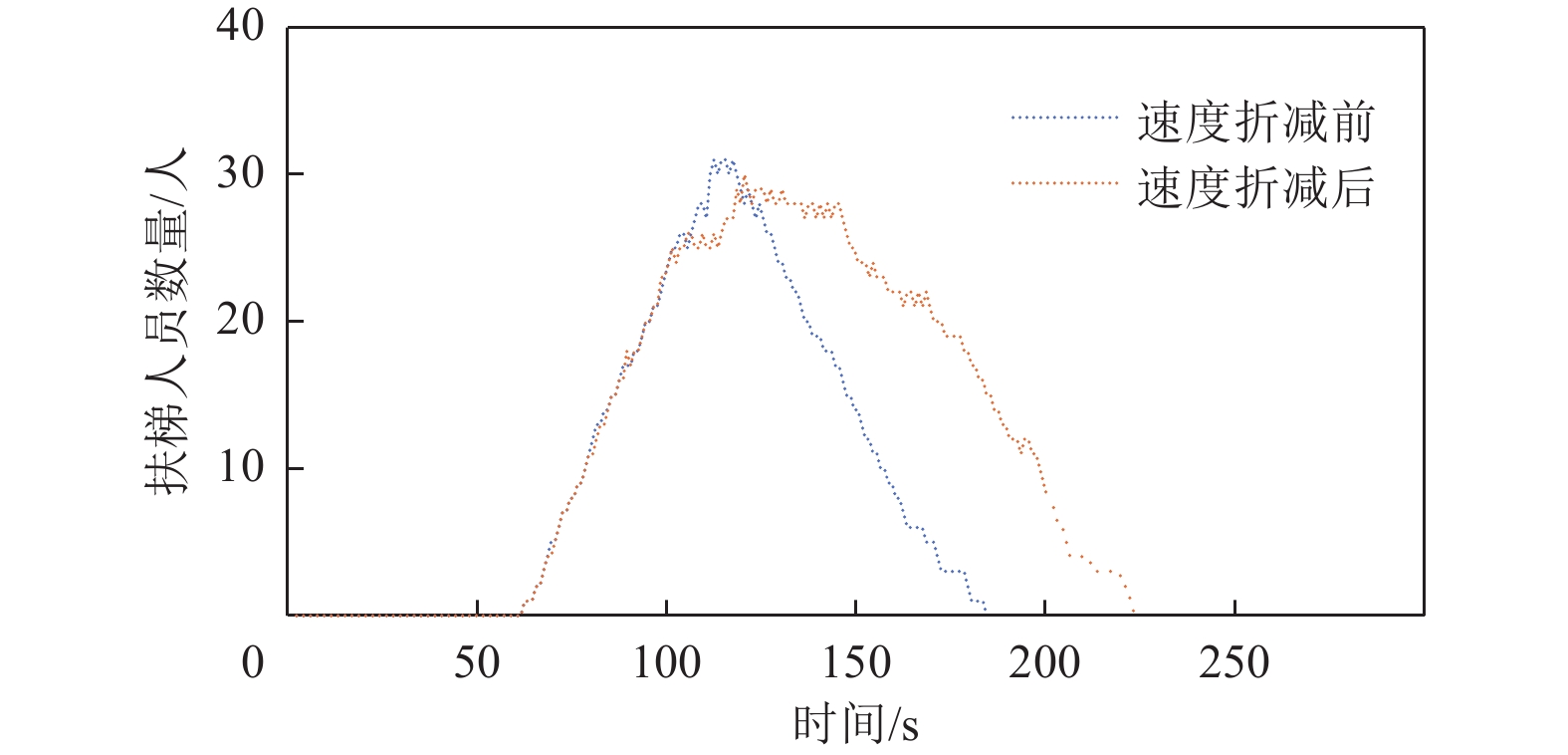Research on Emergency Evacuation of Earthquake Secondary Fire in the Subway System
-
摘要: 破坏性地震常伴随地震次生灾害,后果严重。地铁系统作为城市重要通行设施,研究其在地震次生灾害下的应急疏散十分必要。本文以地震次生火灾为例,基于地震次生火灾特点,深入探讨地铁站人员疏散情况。利用Pyrosim软件建立地震次生火灾模型,分析地铁站内部温度、CO浓度、能见度等因素的变化,确定影响人员疏散的关键因素。在此基础上,使用Pathfinder软件建立人员疏散模型,研究关键因素人员疏散速度的影响,从而获得更准确的疏散动态。研究结果表明,能见度是影响人员疏散的关键因素;此外,楼/扶梯处能见度下降导致疏散速度降低,尤其是在靠近火源位置的楼/扶梯上,滞留时间显著增加。Abstract: Destructive earthquakes are often accompanied by secondary disasters, which can lead to severe consequences. The urban subway system, as a vital transportation infrastructure, necessitates thorough study of emergency evacuation procedures in the event of earthquake-induced secondary disasters. This study focuses on earthquake secondary fires as a representative example. Based on the characteristics of such fires, it conducts an in-depth investigation into the evacuation behavior of subway station occupants. Using PyroSim software, an earthquake secondary fire model is established to analyze variations in internal temperature, CO concentration, visibility, and other critical factors within the subway station, thereby identifying the key factors influencing evacuation. Subsequently, a pedestrian evacuation model is developed using Pathfinder software to examine how these factors affect evacuation speed and dynamics, enabling a more accurate assessment of evacuation processes. The results demonstrate that visibility is the primary factor impacting evacuation efficiency. Moreover, reduced visibility on escalators notably decreases evacuation speed, particularly on escalators near the fire source, resulting in a significant increase in occupant residence time.
-
Key words:
- Subway system /
- Earthquake secondary disaster /
- Fire simulation /
- Emergency evacuation
1)1 https://www.bilibili.com/video/av957969364/ -
表 1 预测远期高峰客流量(单位:人/h)
Table 1. Peak passenger flow in the long term prediction(Unit: person/h)
项目 下行方向 上行方向 上车 下车 断面 上车 下车 断面 客流量/(人·h−1) 2924 117 9991 108 2819 12125 表 2 人员特性表
Table 2. Personnel characteristics
类别 儿童 成年男性 成年女性 老人 步行速度/(m·s−1) 0.79 1.28 1.15 0.86 平均肩宽/cm 33 41 38 39 人员比例/% 9 41 39 11 表 3 各楼/扶梯的能见度-速度折减系数
Table 3. The reduction coefficient of visibility of the escalators on each floor with speed
时间/s 折减系数 1号扶梯 2号楼梯 3号楼梯 2、3号楼梯 4号扶梯 0 1.00 1.00 1.00 1.00 1.00 30 1.00 1.00 1.00 1.00 1.00 60 1.00 1.00 1.00 1.00 1.00 90 1.00 1.00 1.00 1.00 1.00 120 1.00 1.00 1.00 1.00 1.00 150 0.44 1.00 1.00 1.00 1.00 180 0.28 1.00 1.00 0.81 1.00 210 0.21 0.76 1.00 1.00 1.00 240 0.22 0.63 1.00 0.70 0.85 270 0.20 0.49 0.64 0.46 0.63 300 0.20 0.41 0.47 0.37 0.45 330 0.20 0.36 0.44 0.45 0.45 360 0.20 0.31 0.33 0.41 0.43 表 4 各区域滞留时间
Table 4. Stay time in each region
滞留时间 预反应 站台层 1号扶梯 速度折减前 60.0 s 88.0 s 53.5 s 速度折减后 60.0 s 88.0 s 64.1 s 增长率 0.0% 0.0% 19.8% -
陈绍宽,狄月,史荣丹等,2017. 地铁车站站台火灾影响分析与人员疏散研究. 交通运输系统工程与信息,17(1):241−248.Chen S. K., Di Y., Shi R. D., et al., 2017. Simulation and analysis on impacts and evacuation during the process of fire on metro platforms. Journal of Transportation Systems Engineering and Information Technology, 17(1): 241−248. (in Chinese) 陈素文,李国强,2008. 地震次生火灾的研究进展. 自然灾害学报,17(5):120−126. doi: 10.3969/j.issn.1004-4574.2008.05.020Chen S. W., Li G. Q., 2008. Advance in research on secondary fire of earthquake. Journal of Natural Disasters, 17(5): 120−126. (in Chinese) doi: 10.3969/j.issn.1004-4574.2008.05.020 崔春义,许民泽,许成顺等,2025. 考虑地震需求统计不确定性的地铁车站结构地震易损性分析. 岩土工程学报,47(3):453−462. doi: 10.11779/CJGE20230980Cui C. Y., Xu M. Z., Xu C. S., et al., 2025. Seismic fragility analysis of subway station structures considering statistical uncertainty of seismic demands. Chinese Journal of Geotechnical Engineering, 47(3): 453−462. (in Chinese) doi: 10.11779/CJGE20230980 杜修力,李洋,许成顺等,2018. 1995年日本阪神地震大开地铁车站震害原因及成灾机理分析研究进展. 岩土工程学报,40(2):223−236. doi: 10.11779/CJGE201802002Du X. L., Li Y., Xu C. S., et al., 2018. Review on damage causes and disaster mechanism of Daikai subway station during 1995 Osaka-Kobe Earthquake. Chinese Journal of Geotechnical Engineering, 40(2): 223−236. (in Chinese) doi: 10.11779/CJGE201802002 李丹辰,钟茂华,梅棋等,2019. 地铁同站台高架换乘车站火灾人员疏散研究. 中国安全生产科学技术,15(6):5−11.Li D. C., Zhong M. H., Mei Q., et al., 2019. Study on personnel evacuation of fire in one-platform interchange elevated metro station. Journal of Safety Science and Technology, 15(6): 5−11. (in Chinese) 李宇辉,费瑞振,2022. 地铁隧道火灾烟气蔓延和人员疏散效率研究. 铁道科学与工程学报,19(9):2776−2784.Li Y. H., Fei R. Z., 2022. Study on smoke spreading and evacuation efficiency in subway tunnel fire. Journal of Railway Science and Engineering, 19(9): 2776−2784. (in Chinese) 陆新征,岳清瑞,许镇等,2024. 城市密集建筑区新型地震次生灾害研究进展. 工业建筑,54(2):25−34. doi: 10.3724/j.gyjzG23121501Lu X. Z., Yue Q. R., Xu Z., et al., 2024. A review on novel seismic secondary disasters in urban dense building areas. Industrial Construction, 54(2): 25−34. (in Chinese) doi: 10.3724/j.gyjzG23121501 田向亮,钟茂华,陈俊沣等,2019. 地铁十字换乘车站全尺寸实验研究:Ⅰ. 站厅火灾. 中国安全生产科学技术,15(3):11−18.Tian X. L., Zhong M. H., Chen J. F., et al., 2019. Full-scale experimental study on cross transfer metro station: I. Station hall fire. Journal of Safety Science and Technology, 15(3): 11−18. (in Chinese) 王国波,刘强,王鸿杰等,2022. 震后地下结构在火灾下的力学性能初步分析. 岩土工程学报,44(S2):30−35. doi: 10.11779/CJGE2022S2007Wang G. B., Liu Q., Wang H. J., et al., 2022. Preliminary analysis of mechanical properties of subway station under fire after earthquake. Chinese Journal of Geotechnical Engineering, 44(S2): 30−35. (in Chinese) doi: 10.11779/CJGE2022S2007 王建国,刘颖,苏俊凯等,2019. 地铁火灾人员疏散行为影响因素研究. 消防科学与技术,38(5):706−709. doi: 10.3969/j.issn.1009-0029.2019.05.030Wang J. G., Liu Y., Su J. K., et al., 2019. Study on influencing factors of evacuation behavior in subway fire. Fire Science and Technology, 38(5): 706−709. (in Chinese) doi: 10.3969/j.issn.1009-0029.2019.05.030 王建国,樊亦洋,刘颖等,2020. 地铁火灾群体恐慌对非适应性疏散行为影响研究. 消防科学与技术,39(6):856−859. doi: 10.3969/j.issn.1009-0029.2020.06.033Wang J. G., Fan Y. Y., Liu Y., et al., 2020. Study on the influence of group panic on non-adaptive evacuation behavior of passengers during a subway fire. Fire Science and Technology, 39(6): 856−859. (in Chinese) doi: 10.3969/j.issn.1009-0029.2020.06.033 王凯,胡经纬,杨涛等,2022. 地铁站火灾烟流特性及协同集控系统. 中国安全科学学报,32(12):133−140.Wang K., Hu J. W., Yang T., et al., 2022. Fire smoke characteristics and collaborative control system in subway stations. China Safety Science Journal, 32(12): 133−140. (in Chinese) 王起全,王帷先,2017. 地铁火灾应急疏散路线规划与对策. 中国安全生产科学技术,13(3):131−136.Wang Q. Q., Wang W. X., 2017. Planning and countermeasures of emergency evacuation route in subway fire. Journal of Safety Science and Technology, 13(3): 131−136. (in Chinese) 王雨婷,田兵伟,左齐,2024. 城市道路交通网络韧性研究进展. 城市与减灾,(3):11−15. doi: 10.3969/j.issn.1671-0495.2024.03.004Wang Y. T., Tian B. W., Zuo Q., 2024. Research progress on network resilience of urban road traffic. City and Disaster Reduction, (3): 11−15. (in Chinese) doi: 10.3969/j.issn.1671-0495.2024.03.004 文波,冯丽,2024. 机械排烟对室内变压器火灾燃烧特性的影响. 西安科技大学学报,44(6):1019−1029.Wen B., Feng L., 2024. Effect of mechanical smoke exhaust on combustion characteristics of indoor transformer fire. Journal of Xi'an University of Science and Technology, 44(6): 1019−1029. (in Chinese) 吴佳梦,朱顺兵,郝雪彤等,2021. 地铁换乘站高峰期火灾及人员疏散模拟研究. 消防科学与技术,40(6):875−879. doi: 10.3969/j.issn.1009-0029.2021.06.022Wu J. M., Zhu S. B., Hao X. T., et al., 2021. Research on fire and evacuation simulation of subway transfer station during peak period. Fire Science and Technology, 40(6): 875−879. (in Chinese) doi: 10.3969/j.issn.1009-0029.2021.06.022 杨鑫刚,单彩虹,陈学哲,2024. 地铁站应急疏散数值模拟研究. 安全与环境学报,24(1):250−256.Yang X. G., Shan C. H., Chen X. Z., 2024. Numerical simulation study of emergency evacuation in subway stations. Journal of Safety and Environment, 24(1): 250−256. (in Chinese) 张立茂,吴贤国,李博文等,2018. 基于火灾模拟器和Pathfinder的地铁车站人员疏散. 科学技术与工程,18(4):203−209. doi: 10.3969/j.issn.1671-1815.2018.04.032Zhang L. M., Wu X. G., Li B. W., et al., 2018. Fire evacuation of subway station based on fire dynamics simulator and pathfinder. Science Technology and Engineering, 18(4): 203−209. (in Chinese) doi: 10.3969/j.issn.1671-1815.2018.04.032 钟茂华,陈俊沣,陈嘉诚等,2019. 地铁十字换乘车站全尺寸实验研究:Ⅱ. 站台火灾. 中国安全生产科学技术,15(5):42−48.Zhong M. H., Chen J. F., Chen J. C., et al., 2019. Full-scale experimental study on cross transfer metro station: II. Platform fire. Journal of Safety Science and Technology, 15(5): 42−48. (in Chinese) 钟紫蓝,申轶尧,郝亚茹等,2020. 基于IDA方法的两层三跨地铁地下结构地震易损性分析. 岩土工程学报,42(5):916−924. doi: 10.11779/CJGE202005014Zhong Z. L., Shen Y. Y., Hao Y. R., et al., 2020. Seismic fragility analysis of two-story and three-span metro station structures based on IDA method. Chinese Journal of Geotechnical Engineering, 42(5): 916−924. (in Chinese) doi: 10.11779/CJGE202005014 Cha M., Han S., Lee J., et al., 2012. A virtual reality based fire training simulator integrated with fire dynamics data. Fire Safety Journal, 50: 12−24. doi: 10.1016/j.firesaf.2012.01.004 Fridolf K., Ronchi E., Nilsson D., et al., 2019. The representation of evacuation movement in smoke-filled underground transportation systems. Tunnelling and Underground Space Technology, 90: 28−41. doi: 10.1016/j.tust.2019.04.016 Iida H., Hiroto T., Yoshida N., et al., 1996. Damage to Daikai subway station. Soils and Foundations, 36(Special): 283−300. doi: 10.3208/sandf.36.Special_283 Kadokura H., Sekizawa A., Takahashi W., 2012. Study on availability and issues of evacuation using stopped escalators in a subway station. Fire and Materials, 36(5-6): 416−428. doi: 10.1002/fam.1097 Roh J. S., Ryou H. S., Park W. H., et al., 2009. CFD simulation and assessment of life safety in a subway train fire. Tunnelling and Underground Space Technology, 24(4): 447−453. doi: 10.1016/j.tust.2008.12.003 Tsukahara M., Koshiba Y., Ohtani H., 2011. Effectiveness of downward evacuation in a large-scale subway fire using fire dynamics simulator. Tunnelling and Underground Space Technology, 26(4): 573−581. doi: 10.1016/j.tust.2011.02.002 Wang J., Main I. G., 2023. Strong historical earthquakes and their relationships with the Tan-Lu fault system and modern seismicity in eastern China. Natural Hazards, 115(1): 539−564. doi: 10.1007/s11069-022-05565-8 Zalok E., Hadjisophocleous G. V., 2011. Assessment of the use of fire dynamics simulator in performance-based design. Fire Technology, 47(4): 1081−1100. doi: 10.1007/s10694-009-0117-5 -




 下载:
下载:


